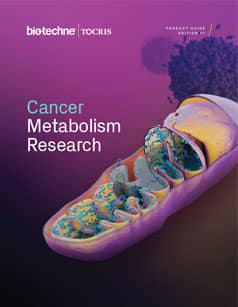Hypoxia Inducible Factors (HIF)
Hypoxia Inducible Factors (HIFs) are transcription factors that are activated in response to decreased oxygen availability in the cellular environment. They influence cell metabolism, cell survival and angiogenesis to maintain biological homeostasis.
Hypoxia Inducible Factor (HIF) Inhibitors |
|
|---|---|
| Cat. No. | 产品名称/活性 |
| 5953 | Adaptaquin |
| HIF-prolyl hydroxylase-2 (PHD2) inhibitor; antioxidant | |
| 5582 | TAT-cyclo-CLLFVY |
| Selective HIF-1 dimerization inhibitor | |
| 4408 | DMOG |
| Inhibitor of hypoxia-inducible factor α (HIF-α) prolyl hydroxylase (HIF-PH) | |
| 5520 | Echinomycin |
| Highly potent and selective HIF-1α inhibitor | |
| 6653 | FM19G11 |
| HIF α-subunit inhibitor | |
| 5655 | GN 44028 |
| Potent HIF-1α inhibitor | |
| 4451 | IOX 2 |
| Potent, selective HIF-1α prolyl hydroxylase-2 (PHD2) inhibitor | |
| 4324 | KC7F2 |
| HIF-1α inhibitor; down-regulates HIF-1α protein synthesis | |
| 6322 | LW 6 |
| HIF-1α inhibitor; inhibits cellular accumulation of HIF-1α; also malate dehydrogenase-2 inhibitor | |
| 2954 | PX 12 |
| Thioredoxin-1 inhibitor; attenuates expression of HIF-1α | |
| 5243 | TC-S 7009 |
| High affinity and selective HIF-2α inhibitor | |
| 7774 | VH 032 |
| Inhibitor of VHL; blocks interaction of VHL and HIF-α | |
| 6156 | VH 298 |
| High-affinity inhibitor of VHL; blocks interaction of VHL and HIF-α | |
Other |
|
| Cat. No. | 产品名称/活性 |
| 6157 | cis VH 298 |
| Negative control for VH 298 | |
| 5764 | Deferoxamine mesylate |
| Hypoxia mimetic; also iron chelator | |
Hypoxia Inducible Factors (HIFs) are transcription factors that are activated in response to decreased oxygen availability in the cellular environment. They influence cell metabolism, cell survival and angiogenesis to maintain biological homeostasis. The HIF family is made up of α subunits (HIF-1, HIF-2 and HIF-3) and a constitutively expressed β subunit (ARNT; also known as Aryl hydrocarbon Receptor Nuclear Translocator).
The best characterized hypoxia response pathway is mediated by hypoxia-inducible factor-1 (HIF-1). In normoxia (when oxygen is present), prolyl hydroxylases 1-3 (PHD1-3) control the degradation of HIF-1α through hydroxylating several proline residues located at the oxygen-dependent degradation domain of HIF-1α. Hydroxylated HIF-1α interacts with von Hippel-Lindau (VHL) protein targeting it for proteasomal degradation. In hypoxia (the absence of oxygen), the HIFα subunit is stabilized due to the lack of oxygen; it translocates to the nucleus, where it dimerizes with the nuclear HIF-1β (ARNT) to form the transcriptionally active HIF. By interacting with the co-activator CBP/p300, HIF-1 activates transcription of target genes that fall into four major categories: glucose transporters and glycolysis, angiogenesis, survival and proliferation, as well as invasion and metastasis. HIF-2α appears to also be regulated by this mechanism; however, HIF-3α may have a different role in the inhibition of HIF-1α and HIF-2α. HIF thereby regulates gene expression through interaction with specific hypoxic response elements (HRE) on hypoxic responsive genes.
HIF-1α has been shown to play an important role in the tumor response to hypoxia. Hypoxia increases tumor glycolysis, angiogenesis and other survival responses, as well as invasion and metastasis, by activating relevant genes through HIFs. HIF-1α activity in tumors has been correlated with increased angiogenesis and aggressive tumor growth, and therefore has led to current interest in HIF-1α as a pharmacological target within cancer research.
Hypoxia also induces epigenetic changes in chromatin architecture and DNA methylation status, and HIF-1α has also been suggested to regulate several histone demethylase enzymes.
Literature for Hypoxia Inducible Factors (HIF)
Tocris offers the following scientific literature for Hypoxia Inducible Factors (HIF) to showcase our products. We invite you to request* your copy today!
*Please note that Tocris will only send literature to established scientific business / institute addresses.
Cancer Metabolism Research Product Guide
This product guide reviews some of the main areas in cancer metabolism research and lists around 150 products that can be used to investigate metabolic pathways in cancer including:
- Glycolysis
- Tricarboxylic Acid Cycle
- Lipidogenesis
- 1C Metabolism and Nucleic Acid Synthesis
- Drivers of Metabolic Reprogramming
- pH and Redox Balance
Hypoxia Inducible Factor Gene Data
| Gene | Species | Gene Symbol | Gene Accession No. | Protein Accession No. |
|---|---|---|---|---|
| Hypoxia Inducible Factor 1, alpha subunit | Human | HIF1A | NM_001530 | Q16665 |
| Mouse | Hif1a | NM_010431 | Q61221 | |
| Rat | Hif1a | NM_024359 | O35800 | |
| Hypoxia Inducible Factor 1, alpha subunit inhibitor | Human | HIF1AN | NM_017902 | Q9NWT6 |
| Mouse | Hif1an | NM_176958 | Q8BLR9 | |
| Rat | Hif1an | NM_001113749 | B0BNG5 | |
| Hypoxia Inducible Factor 3, alpha subunit | Human | HIF3A | NM_152796 | Q9Y2N7 |
| Mouse | Hif3a | NM_016868 | Q0VBL6 | |
| Rat | Hif3a | NM_022528 | Q9JHS2 | |
|
Aryl hydrocarbon Receptor Nuclear Translocator
(ARNT, HIF-1β) |
Human | ARNT | NM_001197325 | P27540 |
| Mouse | Arnt | NM_001037737 | P53762 | |
| Rat | Arnt | NM_012780 | P41739 | |
|
Endothelial PAS domain protein 1
(EPAS, HIF2A) |
Human | EPAS1 | NM_001430 | Q99814 |
| Mouse | Epas1 | NM_010137 | P97481 | |
| Rat | Epas1 | NM_023090 | Q9JHS1 | |
| SET domain containing 2 (HIF-1) | Human | SETD2 | NM_014159 | Q9BYW2 |
| Mouse | Setd2 | NM_001081340 | E9Q5F9 | |
| Rat | Setd2 | NM_001108189 | D4AA96 |

